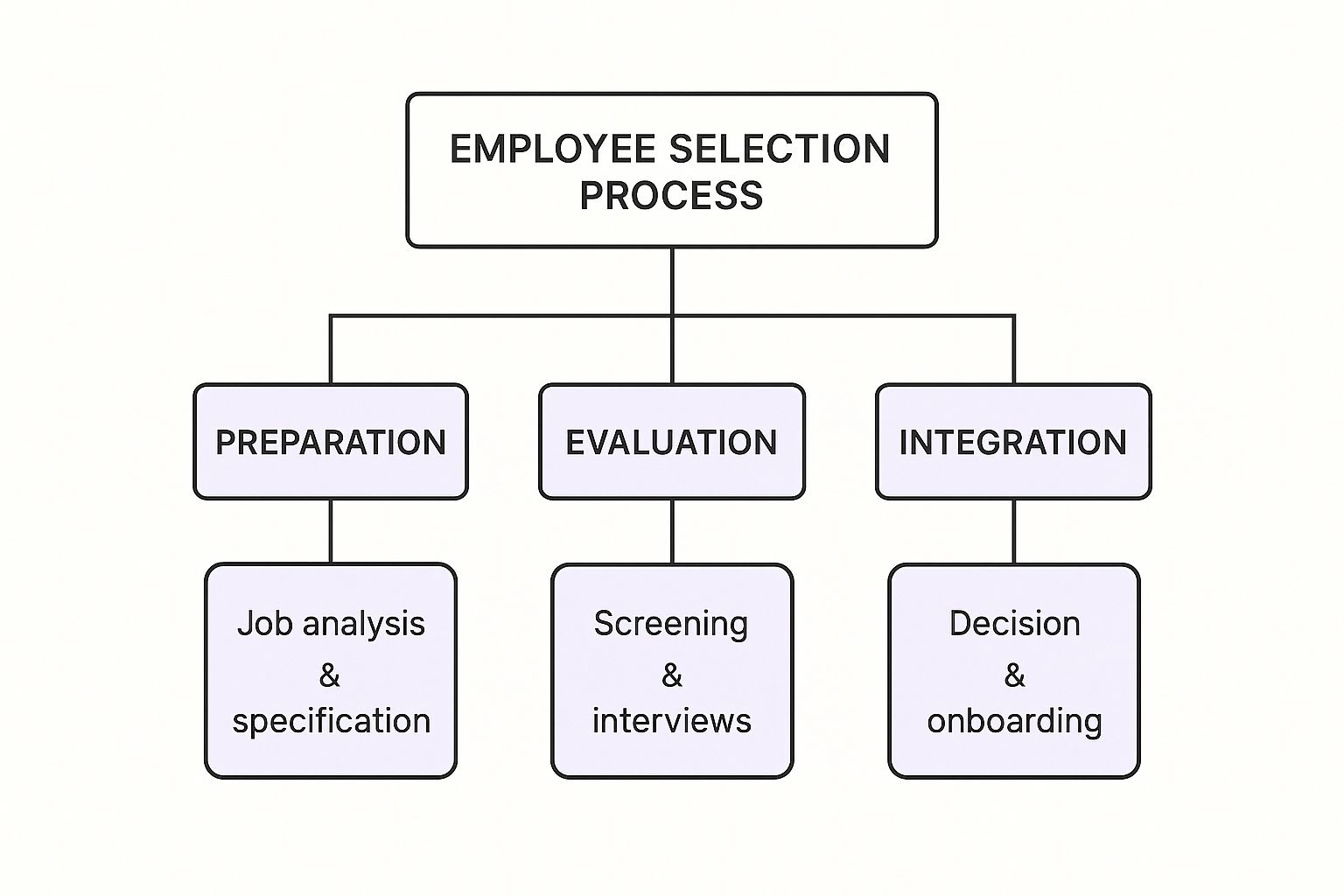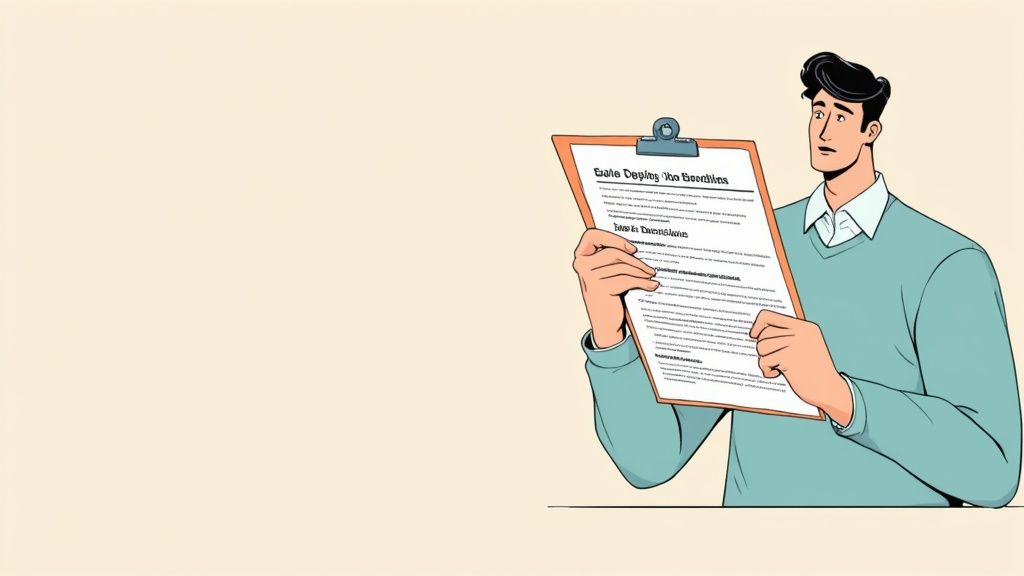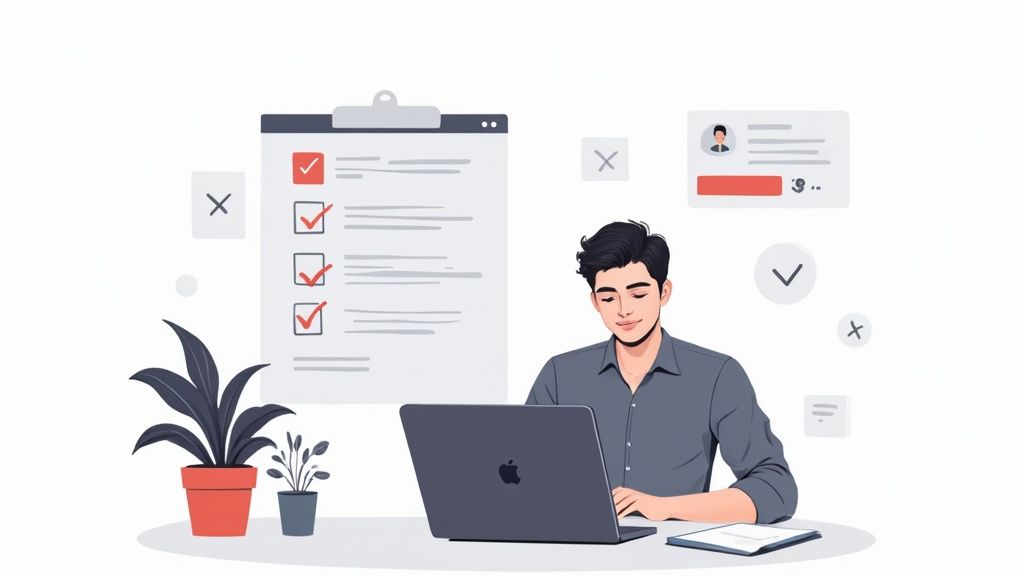
The employee selection process is a deliberate, multi-stage method that companies use to find, evaluate, and ultimately hire the best possible person for a job. It’s far more than just filling an empty seat—it's about strategically acquiring talent that adds fuel to your growth, strengthens your company culture, and keeps people around for the long haul. A structured process will always beat reactive hiring.
Think of building a world-class company like putting together a championship sports team. You don't just grab any player who happens to be available. You scout for specific talent with the right skills, a collaborative mindset, and a genuine drive to win. The modern employee selection process is your strategic playbook for building that winning team.
This structured approach is more critical now than ever before. For example, the U.S. labor market has shown some interesting trends. In late 2023, even with economic uncertainty in the air, job openings saw a 3% increase and applications shot up by a surprising 13% compared to the previous quarter. This signals fierce competition for the best people out there.
At its heart, a successful selection process organizes hiring into clear, predictable phases. This structure is what ensures every candidate gets a fair shot, hiring managers make consistent decisions, and everyone has a better experience. It breaks down the entire journey, from identifying a new role to welcoming a new team member.
The infographic below illustrates the three main clusters that make up the employee selection process.

As you can see, the process flows logically from initial prep and evaluation all the way to final integration. This ensures no critical step gets skipped along the way.
To give you a clearer picture, here’s a quick overview of the seven stages we'll be exploring in this guide.
| Stage | Primary Objective |
|---|---|
| 1. Job Analysis | Define the role's duties, requirements, and success metrics. |
| 2. Sourcing | Actively find and attract a diverse pool of qualified candidates. |
| 3. Screening | Quickly filter applicants to identify the most promising individuals. |
| 4. Assessment | Objectively measure candidates' skills, abilities, and potential. |
| 5. Interviewing | Evaluate soft skills, cultural fit, and validate technical expertise. |
| 6. Decision & Offer | Select the best candidate and extend a competitive job offer. |
| 7. Onboarding | Integrate the new hire smoothly into the team and company culture. |
Each stage serves a distinct purpose, building on the one before it to guide you toward the right hire.
Without a defined process, hiring can quickly become chaotic. It turns into a reactive scramble that often leads to bad hires, costing the company precious time and money. A well-designed selection framework, on the other hand, brings several major advantages to the table:
A great selection process isn't just a filter; it's a magnet. It attracts high-caliber individuals by signaling that your organization values structure, fairness, and excellence from the very first interaction.
Ultimately, mastering this process is a huge competitive advantage. While the core principles apply everywhere, the specifics can change dramatically depending on the role. For a deep dive into hiring for a highly specialized field, this Ultimate Guide to Hiring Top AI Engineers offers fantastic insights. But no matter the position, the goal is always the same: to build a team that doesn't just work, but wins.

The best employee selection processes begin long before the first resume lands in your inbox. Think of it like building a custom home. You wouldn't just start ordering lumber and windows without a detailed blueprint. In the same way, you can't find the right person for a role until you’ve clearly defined what success looks like.
This foundational stage is all about two intertwined activities: figuring out what you truly need and then proactively finding the people who meet that need. These first steps set the tone for your entire hiring effort. Get them right, and you have a clear north star. Get them wrong, and you're just sailing without a map—you’ll drift aimlessly and end up far from where you wanted to be.
First things first: you need to create what we’ll call a "success profile." This goes much deeper than a standard job description. A job description lists duties and qualifications, but a success profile defines what it takes for someone to truly excel and thrive within your specific company culture.
It’s the difference between saying “must know Python” and defining “must be able to use Python to build scalable microservices that integrate with our existing legacy systems.” To build this profile, you have to collaborate with key stakeholders—especially the hiring manager and the team members who will work alongside the new hire.
Your success profile should clearly outline:
Once your success profile is locked in, you can start the search. The old "post and pray" method—just posting a job ad and hoping for the best—is dead. In today’s competitive talent market, modern sourcing is an active, multi-channel hunt for the best possible candidates, including those who aren't even looking for a new job.
Sourcing isn't just about finding applicants; it's about building relationships. A robust talent pipeline is your greatest competitive advantage, giving you a pool of warm, engaged candidates before you even have an official opening.
A powerful sourcing engine combines different channels to maximize your reach and the quality of your candidates. For instance, employee referral programs are a goldmine. They often bring in candidates who are a better cultural match and have higher retention rates because they’ve already been vouched for by your own trusted team members.
Your sourcing strategy should be a balanced mix of different approaches:
By starting with a crystal-clear picture of your needs and then proactively hunting for talent, you shift the employee selection process from a reactive chore into a strategic function that directly fuels business growth.
Once your sourcing engine starts humming and applications pour in, a new challenge begins: figuring out who the real contenders are. This is where smart screening and assessment come into play, helping you separate the signal from the noise and focus your energy on candidates with the highest potential. It's a lot like panning for gold—you need a reliable system to wash away the silt and find those valuable nuggets.
The first part of screening is all about efficiency and fairness. For most companies today, an Applicant Tracking System (ATS) is the first line of defense. This software automates the initial resume review, scanning for specific keywords, skills, and experiences that align with the success profile you already built. It’s a lifesaver for managing high volumes of applicants without completely overwhelming your recruiting team.
But relying only on an ATS can be a double-edged sword. If it isn't configured with a human touch, it can easily filter out fantastic candidates who come from non-traditional backgrounds or just happen to use different words on their resumes. The secret is to use it for the initial sort, not as the final judge.
A resume tells you what a candidate has done. Assessments, on the other hand, tell you what they can do. This is a critical shift, moving from reviewing past experiences to predicting future performance. By layering in a few different types of assessments, you build a much more complete and objective picture of each person's true capabilities.
This data-driven approach is absolutely essential in a market where finding the right person is a constant struggle. In 2024, a staggering 77% of organizations reported having a tough time filling full-time roles. The two biggest roadblocks? 60% of recruiters said they didn't have enough applicants, and 55% felt crushed by competition from other employers. Assessments give you a real competitive edge, helping you spot top talent faster and with far more confidence.
There are several kinds of assessments you can deploy, and each one gives you a different piece of the puzzle.
The goal isn't to chase a perfect score. It's about gathering multiple data points to make a well-informed decision. When you combine these methods, you naturally reduce bias and get a much more well-rounded view of each applicant.
Moving from resume screening to multi-faceted assessment is like switching from a black-and-white photograph to a high-definition video. You see more detail, more context, and a much clearer picture of who the person really is.
By weaving these tools into your hiring workflow, you ensure your process is both efficient and truly effective. To see how these evaluations fit into a bigger picture, check out our guide on using pre-employment skills testing to hire better talent.
Next up, we'll talk about how to bring all this data to life in the interview.

After sifting through resumes and analyzing assessment scores, the interview is where your selection process truly comes to life. This is your chance to go beyond the data, validate a candidate's claimed skills, understand their thought process, and—most importantly—see if the chemistry feels right. Think of it like a final test drive; the specs look fantastic on paper, but you need to feel how the car actually handles on the road.
A great interview is so much more than just small talk and gut feelings. In fact, a poorly run interview can be worse than useless—it can actively mislead you into making a costly bad hire. The real goal is to create a structured, consistent experience that helps you accurately predict who will succeed in the role. That means walking in with a clear plan for what you need to find out and how you're going to get that information.
Not all interviews are created equal. Different formats serve different purposes throughout the employee selection process, and using a strategic mix is key to efficiently filtering candidates and making a well-rounded final decision.
An interview is not an interrogation; it's a conversation with a purpose. The best interviews are a two-way street where both the company and the candidate are evaluating each other for a potential long-term partnership.
If there's one change that will dramatically improve your hiring outcomes, it's adopting the structured interview. This simply means asking every candidate for a given role the same set of predetermined questions, in the same order. This consistency is your single best defense against unconscious bias, forcing you to compare candidates on the substance of their answers, not just on how much you "liked" them.
A core part of this approach is relying on behavioral questions. Instead of asking hypotheticals like, "How would you handle a difficult client?" you ask for real-world proof: "Tell me about a time you had to handle a difficult client. What was the situation, and what did you do?"
This is where the STAR method becomes an interviewer's best friend. It provides a simple, memorable framework for guiding candidates to give you complete, concrete examples of their past behavior.
By steering the conversation with this framework, you transform a casual chat into a powerful data-gathering exercise. You get detailed stories that reveal actual skills, problem-solving abilities, and work ethic in action, making your final hiring decision far more reliable. Plus, a fair, respectful, and well-organized interview process is a branding tool in itself—it sells your company just as much as the candidate is selling themself.

You’ve found your star player. After rounds of tough assessments and insightful interviews, one person has clearly risen to the top. This final stage of the employee selection process isn't just about closing the deal—it's about setting them up for a spectacular win right from the start.
This is no time for gut feelings to take over. The decision to hire should be just as data-informed as every step that led you here. By using a standardized interview scorecard, where every interviewer grades candidates on the exact same criteria, you can compare apples to apples. This simple tool helps neutralize unconscious bias and keeps everyone focused on the skills you actually need, ensuring the most qualified person gets the offer.
Once your decision is locked in, you need to move fast. A great candidate won't stay on the market for long, so a timely, professional offer is non-negotiable. The best approach is often a verbal offer first, quickly followed by a clear, comprehensive, and competitive written one.
Remember, the offer letter is a legal document, so precision is key. It should always include:
Be ready to negotiate. Top talent knows their worth, so don't view this as a confrontation. Think of it as your first collaboration. A positive, respectful negotiation can actually reinforce their decision to join your team.
The employee selection process doesn't end when the candidate says "yes." In fact, a signed offer is just the beginning of the final phase: strategic onboarding. This is where you transform a promising new hire into a truly productive and integrated team member.
Onboarding is the bridge between a great hire and a great employee. A weak bridge can cause even the most talented new hire to fall through the cracks, leading to early turnover and a completely wasted recruitment effort.
Effective onboarding is so much more than just paperwork and a new laptop. A world-class program is a structured journey built for cultural immersion and rapid productivity. A great program often includes:
In a competitive market, a strong onboarding experience is your secret weapon against turnover. Data shows that 51% of organizations see recruiter turnover as their biggest hurdle. To fight this, 40% of talent leaders are now focusing more on building strong candidate relationships. That relationship-building can't stop once the offer is signed. To ensure a smooth transition and long-term success, focusing on effective onboarding best practices is just as crucial as the selection process itself.
A great employee selection process doesn’t end when an offer is signed—it’s a living system that should constantly evolve. How do you know if your hiring playbook is actually working? By measuring what matters and using technology to make smarter decisions. This is all about turning a linear set of steps into a dynamic feedback loop that gets better with every single hire.
Think of it like a professional sports team analyzing game footage. They don't just pop the champagne after a win; they break down every play to see what worked, what didn't, and where they can find a competitive edge for the next matchup. For you, data is your game footage.
To really improve your hiring, you have to track the right Key Performance Indicators (KPIs). These numbers go way beyond just counting applications. They reveal bottlenecks, highlight hidden opportunities, and ultimately tell the story of your hiring success—or lack thereof. While there are plenty of metrics you could obsess over, three stand out as non-negotiable.
These core metrics give you a balanced view of your hiring engine's speed, cost, and most importantly, its impact on the business.
Quality of Hire is the true north of your recruitment efforts. While Time-to-Fill and Cost-per-Hire measure the efficiency of your process, Quality of Hire measures its effectiveness—did you actually bring the right person onto the team?
The industry is clearly shifting toward using hard data to prove hiring success. A recent 2024 survey showed that 66% of talent professionals track Time-to-Fill, 60% monitor new-hire retention, and 44% evaluate hiring manager satisfaction to understand their impact. You can discover more insights about how talent leaders are measuring success in this latest HR and talent statistics research.
Artificial Intelligence isn't some futuristic concept for hiring anymore; it’s a practical tool that can supercharge your entire process. AI works alongside your team, automating the grunt work and serving up data-driven insights that were once impossible to gather. This frees up your recruiters to focus on what they do best: building genuine human connections.
The goal here is to make faster, smarter, and less biased decisions. For example, AI can analyze interview transcripts to pinpoint key competencies or flag inconsistencies, adding a layer of objective analysis to the very human act of a conversation. To really get the most out of this, check out a guide to using AI for meeting notes, which can completely change how you capture and analyze interview data.
AI can directly improve each of the key metrics you track:
To put it all together, let's look at how these pieces fit. The table below shows the key metrics we've discussed and how AI directly enhances each one.
| Key Metric | What It Measures | How AI Can Help |
|---|---|---|
| Time-to-Fill | The speed of your hiring process, from job opening to offer acceptance. | Automated Screening: Instantly filters resumes to surface top candidates. Intelligent Scheduling: Coordinates interviews across multiple calendars automatically. |
| Cost-per-Hire | The total financial investment required to make a single hire. | Targeted Sourcing: Reduces ad spend by identifying high-potential candidates on cheaper channels. Optimized Job Ads: Uses NLP to write posts that attract the right applicants, lowering cost-per-application. |
| Quality of Hire | The long-term value a new employee brings, measured by performance and retention. | Predictive Analytics: Identifies traits of top performers to find similar candidates. Unbiased Assessments: Focuses on skills and competencies, reducing human bias and improving fit. |
By weaving these metrics and AI-driven enhancements into your workflow, your employee selection process stops being a static checklist and becomes a dynamic, self-improving engine that consistently delivers top talent to your organization.
Even the most carefully planned selection process can throw you a curveball. Let's tackle some of the most common questions that come up, so you can fine-tune your approach and handle any tricky situations with confidence.
It helps to think of it like fishing. Recruitment is all about casting a wide net to attract as many fish (your candidates) as you can into your boat (the talent pool). It’s the process of building awareness, generating interest, and getting people to apply.
The employee selection process, on the other hand, is what you do once the fish are in the boat. It’s the careful, step-by-step process of examining each one to find the absolute best fit for your specific needs. This is where you use tools like assessments and interviews to make your final choice.
There's no one-size-fits-all answer here, since the timeline really depends on the role's complexity and seniority. That said, a solid industry benchmark for most professional roles is somewhere between 30 and 45 days from the day you post the job to the day you extend an offer.
The real key isn’t just speed; it’s momentum. A process that feels responsive and keeps candidates in the loop is far more important than hitting an arbitrary deadline. Stagnation is what kills the deal—it’s when top candidates lose interest and start accepting other offers.
When you look at the data, two methods consistently rise to the top for predicting who will actually perform well on the job:
Combining these two methods gives you a powerful, evidence-based framework for making a hiring decision. It moves you way beyond simple gut feelings and toward a process that’s fair, data-driven, and focused on finding the person who can truly excel.
